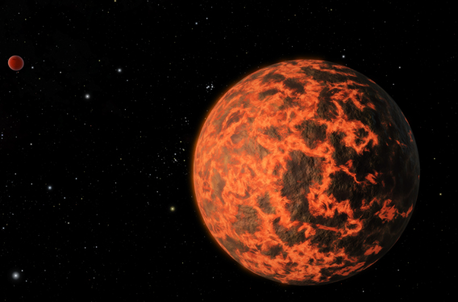Exoplanets
Spitzer Finds Possible Exoplanet Smaller Than Earth
 |
This artist's concept shows what astronomers believe is an alien world just two-thirds the size of Earth -- one of the smallest on record. It was identified by NASA's Spitzer Space Telescope. The exoplanet candidate, known as UCF-1.01, orbits a star called GJ 436, which is located a mere 33 light-years away. UCF-1.01 might be the nearest world to our solar system that is smaller than our home planet. Image credit: NASA/JPL-Caltech
If the roasted, diminutive planet candidate ever had an atmosphere, it almost surely has evaporated. UCF-1.01 might therefore resemble a cratered, mostly geologically dead world like Mercury. Paper co-author Joseph Harrington, also of the University of Central Florida and principal investigator of the research, suggested another possibility; that the extreme heat of orbiting so close to GJ 436 has melted the exoplanet's surface. "The planet could even be covered in magma," Harrington said. In addition to UCF-1.01, Stevenson and his colleagues noticed hints of a third planet, dubbed UCF-1.02, orbiting GJ 436. Spitzer has observed evidence of the two new planets several times each. However, even the most sensitive instruments are unable to measure exoplanet masses as small as UCF-1.01 and UCF-1.02, which are perhaps only one-third the mass of Earth. Knowing the mass is required for confirming a discovery, so the paper authors are cautiously calling both bodies exoplanet candidates for now. Of the approximately 1,800 stars identified by NASA' Kepler space telescope as candidates for having planetary systems, just three are verified to contain sub-Earth-sized exoplanets. Of these, only one exoplanet is thought to be smaller than the Spitzer candidates, with a radius similar to Mars, or 57 percent that of Earth. "I hope future observations will confirm these exciting results, which show Spitzer may be able to discover exoplanets as small as Mars," said Michael Werner, Spitzer project scientist at NASA's Jet Propulsion Laboratory in Pasadena, Calif. "Even after almost nine years in space, Spitzer's observations continue to take us in new and important scientific directions." NASA's Jet Propulsion Laboratory, Pasadena, Calif., manages the Spitzer Space Telescope mission for NASA's Science Mission Directorate, Washington. Science operations are conducted at the Spitzer Science Center at the California Institute of Technology in Pasadena. Data are archived at the Infrared Science Archive housed at the Infrared Processing and Analysis Center at Caltech. Caltech manages JPL for NASA.
Credit: NASA
Exoplanets
Spitzer Finds Possible Exoplanet Smaller Than Earth
 |
This artist's concept shows what astronomers believe is an alien world just two-thirds the size of Earth -- one of the smallest on record. It was identified by NASA's Spitzer Space Telescope. The exoplanet candidate, known as UCF-1.01, orbits a star called GJ 436, which is located a mere 33 light-years away. UCF-1.01 might be the nearest world to our solar system that is smaller than our home planet. Image credit: NASA/JPL-Caltech
If the roasted, diminutive planet candidate ever had an atmosphere, it almost surely has evaporated. UCF-1.01 might therefore resemble a cratered, mostly geologically dead world like Mercury. Paper co-author Joseph Harrington, also of the University of Central Florida and principal investigator of the research, suggested another possibility; that the extreme heat of orbiting so close to GJ 436 has melted the exoplanet's surface. "The planet could even be covered in magma," Harrington said. In addition to UCF-1.01, Stevenson and his colleagues noticed hints of a third planet, dubbed UCF-1.02, orbiting GJ 436. Spitzer has observed evidence of the two new planets several times each. However, even the most sensitive instruments are unable to measure exoplanet masses as small as UCF-1.01 and UCF-1.02, which are perhaps only one-third the mass of Earth. Knowing the mass is required for confirming a discovery, so the paper authors are cautiously calling both bodies exoplanet candidates for now. Of the approximately 1,800 stars identified by NASA' Kepler space telescope as candidates for having planetary systems, just three are verified to contain sub-Earth-sized exoplanets. Of these, only one exoplanet is thought to be smaller than the Spitzer candidates, with a radius similar to Mars, or 57 percent that of Earth. "I hope future observations will confirm these exciting results, which show Spitzer may be able to discover exoplanets as small as Mars," said Michael Werner, Spitzer project scientist at NASA's Jet Propulsion Laboratory in Pasadena, Calif. "Even after almost nine years in space, Spitzer's observations continue to take us in new and important scientific directions." NASA's Jet Propulsion Laboratory, Pasadena, Calif., manages the Spitzer Space Telescope mission for NASA's Science Mission Directorate, Washington. Science operations are conducted at the Spitzer Science Center at the California Institute of Technology in Pasadena. Data are archived at the Infrared Science Archive housed at the Infrared Processing and Analysis Center at Caltech. Caltech manages JPL for NASA.
Credit: NASA






